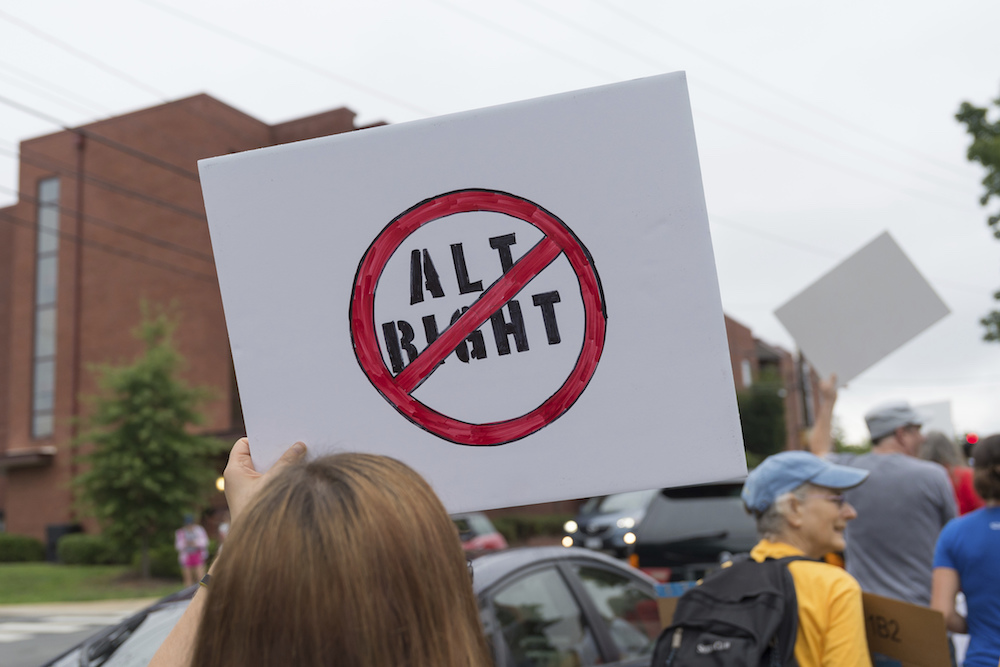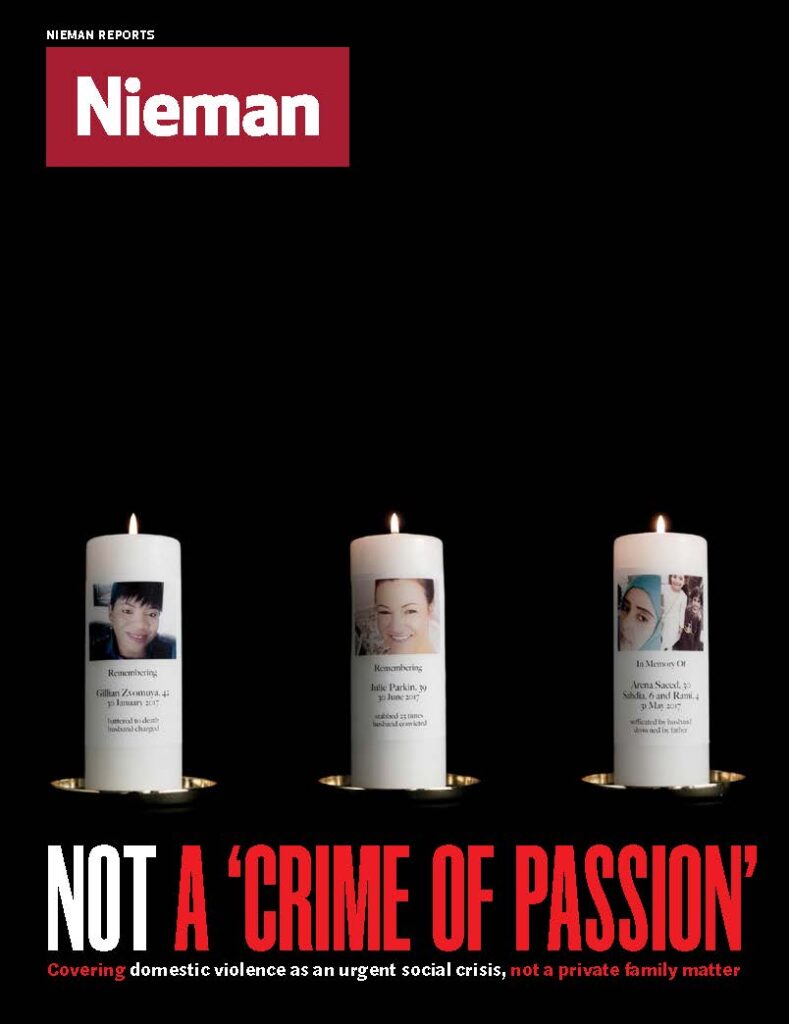Predictably, along with the rise of right extremism, a new reporting genre has arisen with its own ethical and practical dilemmas: the white supremacy and white nationalism beat.
I have a somewhat unique perspective on white supremacy, being an editor, a reporter, and an academic researcher on the topic. And I am an affected community member. My community, my neighbors, and my friends are experiencing the fallout from recruitment activities and increasing radicalization in Appalachia. Members of my family are targets of hate: My son is the imam of our local mosque, and my daughter-in-law, grandchildren, and extended Muslim family members have increased their level of threat assessment as part of daily life.
So I have professional and personal thoughts I’d like to share on covering white nationalism and white supremacy in America.
In April of 2017, 100 Days in Appalachia, which I edit, covered the Pikeville, Kentucky white supremacist rally staged by Matthew Heimbach and the Traditionalist Worker Party along with a motley coalition of uniformed neo-Nazis, military-geared “patriot” groups, and Confederate flag-waving members of the League of the South. The event signaled a moment when many national and international media finally acknowledged the endemic racism rooted in populism that characterized the resurgence of the white ethno-state here and abroad.
A few months after Pikeville we published a historical contextual op-ed that asked our readers to take a good long look in the mirror, and we published a community aftermath piece in response to Charlottesville.
Recall that in Appalachia, and for many other communities across America, Donald Trump’s election was not a surprise. The election and subsequent acceleration of public displays of white nationalism and the increase of hate activities merely confirmed for the rest of the world what for millions was simply lived experience.
I struggled with how to dissect the current administration’s normalization of white nationalism from within a region that overwhelmingly supported Trump, from ensuring we cited the early investigative work of Black women experiencing the online culture that seeded this highly networked, weaponized racism to explaining how this latent cancer was spread by a host of bad actors, from anarchist trolls to Russian agents, and the economic model and ethics vacuum of the social media platforms themselves.
We have quietly accumulated data and acquired a deepening expertise in several overlapping areas of research that are now feeding larger investigative work. Our immersion engendered an increasing respect for the knotty complexities, historical precedents, and political backdrops in the region and around the world, as well as the increasing security risks to my team and their sources and, above all, the peril to affected community members.
I thought it would be helpful to share the kinds of questions I’ve asked myself as an editor and explain why we stopped publishing single stand-alone pieces and pivoted to larger cumulative, collaborative, and solutions-focused work.
Who is my audience?
If the answer is“other journalists and researchers,” I’ve declined to publish, and instead have shifted to sharing data directly with a small community of researchers and reporters who I trust and who are credibly engaged in this work. This includes a few journalists investigating this topic at major news organizations, researchers at other academic institutions, members of civic society organizations, and members of the funding community leading platform accountability initiatives based in part on this topic.
In the summer of 2018, I was fortunate to participate in a work session hosted by the research institute Data & Society on the topic of covering hate. Data & Society was founded in 2013 to address social and cultural issues and risks at the intersection of data and technology. In the aftermath of Pikeville and Charlottesville, their researchers had the foresight to recognize the lack of information, shared vocabulary, ethics models, and security practices for journalists wading into this milieu. They created a “scoop-free” environment to dig into the challenges at hand.
The workshop assembled approximately 30 local, regional, and national reporters along with researchers and activists working on this complex issue. Sessions and conversations helped to steer journalists to move past the spectacle of rallies and protests—and the oversimplified, stereotypical “lone-wolf/troubled-individual” coverage that has characterized so much white nationalism reporting—and to provide additional context for placing their coverage in the arc of history.
Perhaps even more importantly, it began to establish a community of practice.
This is ugly, traumatizing, and lonely work. Community is necessary. That said, as difficult as it is for researchers and reporters covering it, I know personally how much more deeply traumatic it is for affected community members living it.
Who is missing?
These are the people, in fact, most consistently left out of coverage: community members experiencing the impact of hate and threats in their lives as well as the rise of radicalization among loved ones.
I understand the rationale behind admonishments to cease reporting on white nationalists at the risk of amplifying hate. And for most of the reporting I’ve read, I agree we need way less of it. Our own internal motto is, “First do no harm.”
But a position of silence may also confer an elite vantage point. Who gets to decide when, where, and what to publish? There is an inherent position of power in suggesting that starving online hate of media oxygen will curtail it in real life when nothing in our lived experience suggests hate is starving, with or without gonzo journalism.
And, to be honest, centering mainstream media in that dynamic exacerbates the problem. Despite all the coverage of far right figures, from my community’s perspective there has been a fundamental failure to see the problem hiding in plain sight. The subtleties of this ecosystem include coded language and an online grooming process decoupled from swastikas and other overt symbols of hate. Decoding these strategies and tactics may help community members identify susceptible individuals and take actions to disrupt the radicalization process before it’s too late.
Does the work offer solutions?
A few weeks ago, a mother in my community sat on my porch and said, “I’m afraid my kid is becoming a Nazi, and I don’t understand why.”
She is not on Twitter following white supremacy journalists or reading research from academics. Even if she were, would that help her? She desperately wants to understand what is happening in our community and in her home, and she deserves to be informed in a way that enables action. She wants more information, not less.
To help her and others achieve that, we are engaging community members as collaborating partners in devising practical interventions, not simply as sources or “characters” in a story. This personal outreach, using old-fashioned community organizing methods, is enabling us to conduct focus groups by word of mouth with parents, youth, teachers, librarians, church leaders and other members of our community who have the potential to disrupt or counter exposure to radicalizing content.
Likewise, our reporting must fully engage the targeted communities of hate. What do each of these affected community members need from this reporting and research? We are asking them. This includes hosting small focus groups in protected settings with Jewish, Muslim, and Black youth and parents and using methods to ensure their anonymity.
If there is anything the past three years of work on this topic has taught me, it is that we need to have the courage and humility to eschew scoops in order to build a larger community of intervention. We need to share and corroborate each other’s data and research. We need to connect the dots across our respective rabbit holes of knowledge and expertise. And this call for collaboration must extend beyond researchers, activists, and journalists to center the needs and questions of affected community members.
The Saturday morning after the Christchurch shooting in New Zealand, in which a man killed 51 and injured many others at two mosques, my extended family sat in resigned sadness in my kitchen. We strategized about security and conducted threat assessments, even as terror overlapped with passing babies lap to lap along with platters of breakfast food.
One of my family members took notes, making a list of things to do. The fact that the piece of paper was set aside with a sigh at the futility of devising solutions tells me something about what is missing in our reporting. The first step is to increase security, the second to consider active shooter training, but subsequent steps to address the systemic problem remain elusive.
While media dwell on trauma and dissects the psychological states of individual characters, what should the third step be?
As journalists and researchers, we must work with our communities to help fill in the blank.




